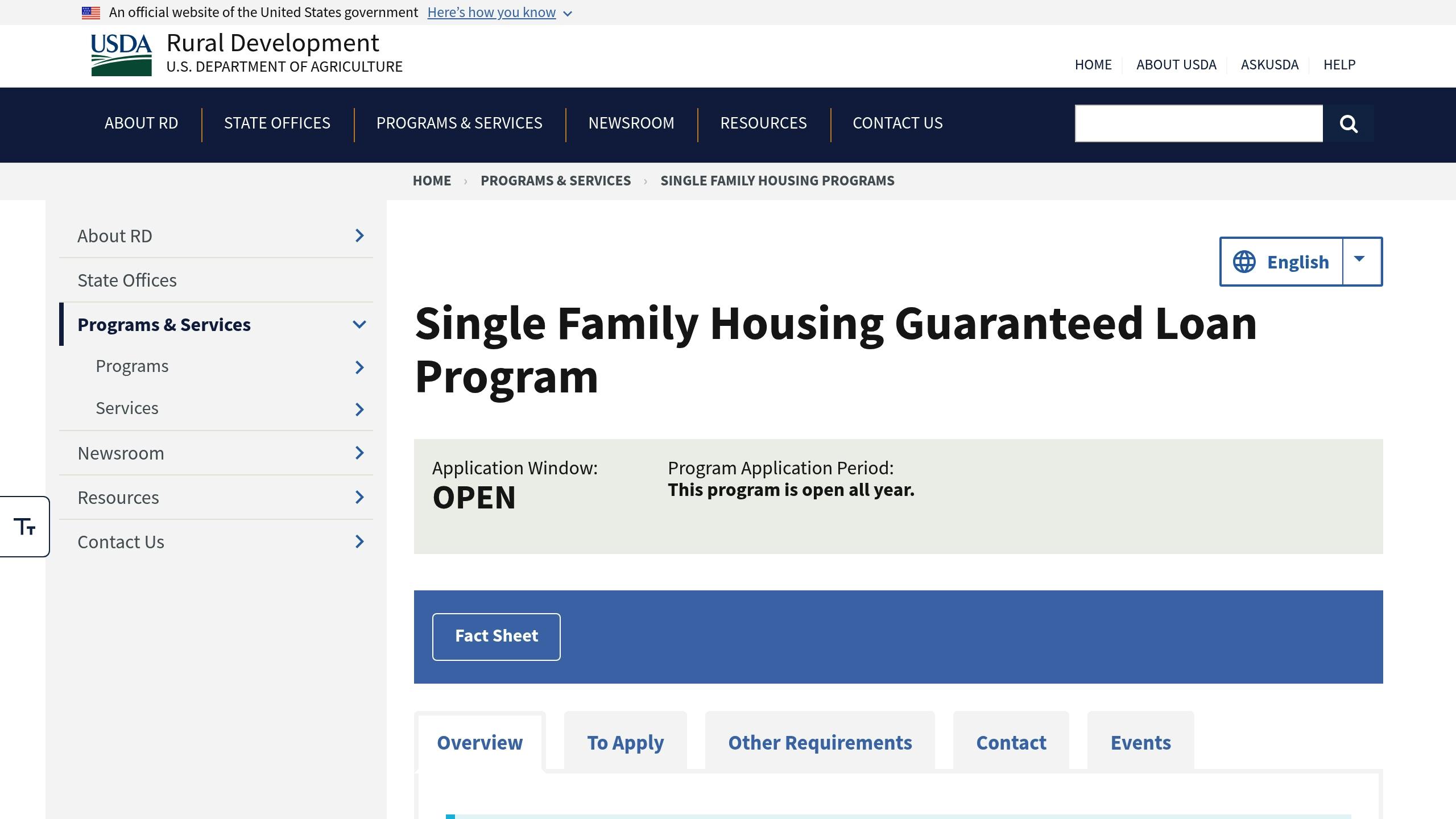Can you really buy a house with no money down? Yes, but it depends on eligibility. Two government-backed programs – VA loans for veterans and USDA loans for rural buyers – allow 100% financing with $0 down payment.
Key Points:
- VA Loans: For veterans and active service members. No down payment, lower interest rates, no PMI, but includes a funding fee.
- USDA Loans: For low- to moderate-income buyers in eligible rural areas. No down payment, but includes guarantee and annual fees.
- Trade-offs: Higher monthly payments, potential for negative equity if home values drop, and closing costs still apply.
Quick Comparison:
| Feature | VA Loans | USDA Loans |
|---|---|---|
| Down Payment | $0 | $0 |
| Income Limits | None | 115% of area median income |
| Property Location | Nationwide | Rural areas (97% of U.S.) |
| Fees | Funding fee (0.5%-3.6%) | Guarantee fee (1% upfront) |
| PMI | Not required | Not required |
Zero-down mortgages are a great option for those who qualify, but they require careful financial planning. Keep reading to learn how these programs work and whether they’re right for you.
Zero Down Payment Comparison – VA, USDA, and Other Mortgage Options
What Are Zero Down Payment Mortgages?
Zero down payment mortgages let buyers finance the entire cost of a property [1]. Unlike traditional loans that require a down payment, these mortgages remove the need to save up a large upfront amount.
These programs date back to the post-World War II era, when the Veterans Administration (VA) began insuring loans to help service members buy homes. During 1949-1953, VA loans accounted for about 24% of the mortgage market, contributing to a surge in American homeownership [5].
Currently, there are two main types of zero-down mortgages:
| Loan Type | Primary Features | Key Requirements |
|---|---|---|
| VA Loans | • Full financing (100%) | • Must qualify based on military service |
| • Minimum credit and debt-to-income requirements | ||
| USDA Loans | • Full financing (100%) | • Property must be in an eligible rural area |
| • Income must fall within program limits |
While these loans waive the down payment, buyers still need to factor in closing costs, which typically range from 3% to 5% of the loan amount [1].
The appeal of zero-down financing is clear:
"Think about all the people who are renting and would love to buy a house, but they face this roadblock of coming up with $10,000 or $15,000 for a down payment. This eliminates that."
– Alex Elezaj, UWM‘s chief strategy officer [4]
However, misconceptions often prevent eligible buyers from exploring these programs. As C.L. Mike Schmidt, a Personal Finance Expert and Attorney, points out:
"These programs often have income limits, but they are usually set at levels that cover a broad range of households. There are plenty of options for moderate to middle-income earners. So, don’t write yourself off based solely on your income bracket."
– C.L. Mike Schmidt, Personal Finance Expert and Attorney at Schmidt & Clark LLP [3]
One important consideration: financing the full purchase price means higher monthly payments. While zero-down mortgages make homeownership more accessible, they require thoughtful financial planning.
1. VA Home Loans
VA home loans make it easier for Veterans, active military members, and surviving spouses to buy a home. These government-backed mortgages supported nearly 750,000 Veterans in financing homes last year, with lending surpassing $250 billion [8].
One standout feature of VA loans is the zero down payment option. Around 80% of Veterans using VA benefits buy homes without a down payment, and about 66% of all VA purchase loans in Fiscal Year 2023 involved no money down [7].
Here’s what makes VA loans appealing:
| Feature | Benefit | Compared to Traditional Loans |
|---|---|---|
| Interest Rates | Usually 0.5–1% lower than conventional rates | Nearly 90% of VA homeowners have rates under 5% [8] |
| Mortgage Insurance | Not required | Saves thousands compared to FHA or conventional loans |
| Credit Requirements | More lenient | Easier to qualify than conventional mortgages |
| Closing Costs | Capped by regulations | Lender fees limited to 1% of the loan amount [9] |
Although no down payment is required, VA loans do come with a funding fee ranging from 0.5% to 3.6% of the loan amount (typically 2.3% for first-time buyers). This fee can be rolled into the loan [9].
Important Notes:
- Veterans without full entitlement may need to provide a down payment [7].
- If the VA appraisal values the home lower than the purchase price, buyers might need to cover the difference out-of-pocket [10].
VA loans also offer added protections, such as foreclosure assistance, no prepayment penalties, capped closing costs, and the ability to reuse the benefit multiple times.
For those who qualify, VA loans combine zero down payments, competitive rates, and long-term savings [8].
Next, we’ll dive into USDA loans and how they stack up against VA loans.
sbb-itb-8115fc4
2. USDA Rural Housing Loans
USDA Rural Housing Loans are government-backed mortgages aimed at helping low- to moderate-income buyers purchase homes in eligible rural areas.
These loans allow buyers to secure financing without a down payment, making them an attractive option for those who qualify. In 2023, the program supported over 35,000 families in becoming homeowners [12]. Covering about 97% of U.S. land and serving 109 million Americans, the program has a wide reach [13].
| Feature | Requirement | Details |
|---|---|---|
| Income Limits | 115% of area median | Depends on location and household size |
| Credit Score | Typically 640+ | Offers more flexible credit requirements |
| Property Location | Rural areas | Towns with populations under 35,000 |
| Annual Fee | Required | Includes an upfront guarantee fee |
| Property Types | Primary residence only | Single-family homes, manufactured homes |
To qualify, borrowers must meet specific requirements. They need to show they can repay the loan, use the property as their primary residence, meet citizenship or eligible non-citizen criteria, and fall within the program’s income limits [11].
Properties must also meet USDA standards. They need to be in eligible areas, have working utilities, be structurally sound, and accessible by paved or all-weather roads [13][14].
Although USDA loans currently have interest rates about 0.251% higher than VA loans in 2024 [12], they often make up for this with lower fees and broader property type eligibility. USDA loans include an upfront guarantee fee and an annual fee, both of which are generally lower than the mortgage insurance premiums on conventional loans [12].
The USDA determines eligible areas based on population density and metropolitan status. Interested buyers can check the USDA property eligibility map to confirm if a property qualifies for financing [13].
Benefits and Drawbacks
Zero down payment mortgages have their perks and challenges, and understanding both is crucial for making solid financial decisions. Let’s break down how the structure of each program affects affordability and risk.
| Feature | VA Loans | USDA Loans |
|---|---|---|
| Down Payment | $0 down [15] | $0 down [16] |
| Property Location | Nationwide flexibility | Rural/suburban areas only (97% of U.S. landmass) [16] |
| Income Requirements | No income limits | 115% or less of area median income |
| Upfront Costs | Funding fee: 1.25% to 3.3% [18] | Guarantee fee: 1% of loan amount [19] |
| Annual Fees | None | 0.35% of loan amount [19] |
| Private Mortgage Insurance (PMI) | Not required [15] | Not required [17] |
Key Benefits
VA loans are a popular choice for eligible Veterans, with 80% of buyers opting for no down payment [7]. These loans come with low interest rates and no PMI, keeping monthly costs more affordable.
USDA loans are designed to help families and individuals in rural areas become homeowners. They also allow penalty-free prepayment, providing extra flexibility [16][17].
Financial Considerations
While zero-down options make homeownership more accessible, they come with trade-offs. Financing upfront fees increases the total loan amount and monthly payments. However, this setup can help buyers keep their savings intact for other priorities, like home repairs or emergencies.
Market Risk Awareness
One downside of zero-down mortgages is the lack of an equity cushion. If home values drop, borrowers may face the risk of negative equity [19].
Program-Specific Requirements
VA loans offer flexibility in property types, including multi-unit homes [21]. On the other hand, USDA loans are limited to single-family homes in rural or suburban areas [22]. Each program also has unique costs: VA loans require a one-time funding fee, while USDA loans include an upfront guarantee fee and smaller annual fees [19][20].
Key Takeaways
When it comes to zero-down financing, understanding the details can make a big difference. Here’s what every potential borrower needs to know about these mortgage options.
Zero-down mortgages, available through programs like VA and USDA loans, can help make homeownership more accessible. However, it’s important to carefully review the eligibility requirements and weigh the financial trade-offs.
VA Loan Eligibility Requirements
- Service Requirements: Active duty service members typically need 90 consecutive days of service during wartime or 181 days during peacetime [2].
- Credit Score: Most lenders look for a minimum FICO score of 620 [2].
USDA Loan Qualifications
- Location: The property must be in a qualifying rural area. Interestingly, about 74% of U.S. land meets this criterion [23].
- Income Limits: For 2025, the income cap is $112,450 for households with 1 to 4 members and $148,450 for households with 5 to 8 members [24].
Financial Considerations for Zero-Down Mortgages
| Factor | Impact |
|---|---|
| Monthly Costs | Higher payments since you’re financing 100% of the home’s purchase price [25] |
| Market Risks | Limited equity means less protection against market value drops |
| Tax Benefits | Potentially larger deductions for mortgage interest [1] |
"A zero down payment mortgage can be a good idea, but there are some drawbacks to consider before taking out this type of loan." – Mel Jones [25]
Smart Preparation Steps
- Check Your Credit: Review your credit report and work on improving your score if needed.
- Budget Wisely: Account for all monthly costs, including taxes and insurance.
- Save for Emergencies: Build a financial cushion to compensate for starting with no equity.
- Negotiate Closely: Aim for seller concessions to help reduce closing costs [25].
With median home prices hitting $468,000 in Q3 2022 [6], zero-down loans appeal to buyers with solid credit and reliable income. However, success depends on meeting strict criteria and planning for the long-term costs.
Related Blog Posts








